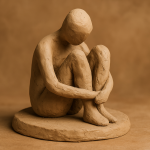Last year, while scrolling through Instagram, I had a sudden realization – I hated my closet. This wasn’t because I didn’t have enough clothes or they weren’t trendy enough – in fact, my closet was overflowing – but because none of them felt like me. My entire closet reflected ideals I’d absorbed through various forms of social media – I needed to look skinnier, more interesting, more “put together”. All of which I believed would make me more palatable and easier to like.
Fashion is meant to be an outlet for creativity and joy – yet somehow, it became a mirror reflecting
everything I believed I wasn’t.
I remember dreading the return of low-rise jeans. I’d miss my baggy pants – the way they allowed my body to feel like a suggestion, not a spotlight. For some reason, I hadn’t even stopped to realize that I didn’t actually need to partake in these trends.
Growing up, (especially as a teenager), clothes were never just clothes. They were forms of silent judgement. When jean shorts stopped fitting after winter, it didn’t just mean I’d grown – it meant, in my mind, that my body was wrong. Crop tops were trophies for perfectly flat, toned stomachs. A way of showcasing you must’ve been on a treadmill for hours or hadn’t decided to peruse the grocery shelves and picked up a brownie instead of a fruit cup. Anything I put on my body when I was younger was a direct result of trying to convey a message to my peers. This wasn’t just my inner voice – it was school hallways, magazine headlines, and countless influencers on my For You Page with impossibly flat stomachs and expensive athleisure that always seemed to fit their bodies exactly.
Our generation has had more access to the world than ever before – and while this can bring a multitude of good things such as better education and worldly awareness, it can also lead to us feeling trapped in our own skin when we’re fed thousands of videos of people with bodies we wished we had. Even trends like the “clean girl” aesthetic make us feel like we’re somehow failing.. It’s difficult to remind yourself that not everyone is actually fortunate enough to wake up at 6am and start their day with an unnaturally green smoothie and an expensive pilates workout. It makes us feel as though we are the ones doing something wrong. The pressure to look “effortlessly perfect” and fit in with those surrounding us, especially over the internet, can become all-consuming. The generation of teenagers currently have the highest rates of body image issues, even in the face of the “self love” movement. Taking small steps towards reclaiming our identities and self-perception is the key to moving in a positive direction regarding body-image and self-appreciation.
But here’s the twist: I decided to stop letting fashion dictate how I should feel about myself – not by changing my body, but by reclaiming style as something playful, expressive, and mine. Fashion standards may impact mental wellbeing, but creativity has the power to flip the script and put us back in charge of our perception of ourselves.
Growing up, I spent most of my childhood wearing princess dresses sewn by my grandma and cutting my own hair. The first time I’d decided to reject the standards around me was when I’d made the decision to dye my hair various shades of the rainbow throughout highschool. That was the first decision I’d ever made because I liked it rather than thinking everyone else would find it appealing. I couldn’t believe making a decision because I wanted to would bring me so much joy – I felt oddly powerful.
Creative expression, whether this is in the form of choosing patterns you like, dying your hair an unnatural colour, or wearing bolder colours than is considered “socially acceptable”, has infinite benefit. Studies have shown that creative expression, especially in fashion, is linked to reduced anxiety and depression, improved self-esteem, and an increase in positive body image. Our bodies should be viewed as a canvas, not a cage. Once I discovered this, I spent hours delving down the rabbit hole of Pinterest, curating inspiration boards for things that felt like me rather than what was currently trendy. I never thought of fashion as a creative outlet, but I soon realized that embracing brighter colours, distinctive belt buckles, and unique patterns was the key to feeling more like myself in my own skin.
So if you’ve ever looked in the mirror and hated what you saw – try inventing your own rules. Walk into a secondhand store and let yourself gravitate toward the sequins, the loud prints, the pieces that make you smile for no logical reason. A weird accessory. A pair of pants that make you feel like you. Dress not for approval, but for joy. You don’t owe anyone an explanation. The first step is seeing fashion not as a way to conform, but as a way to speak – to say, this is me. Remember, our bodies aren’t cages – they’re canvases. And you’ve always been enough.
What if fashion wasn’t about fitting in, but about breaking free? Maybe the most radical thing we can do is dress for ourselves – joyfully, unapologetically, and without permission.



